第二节 形容词与副词
形容词与副词的区别与变化规则
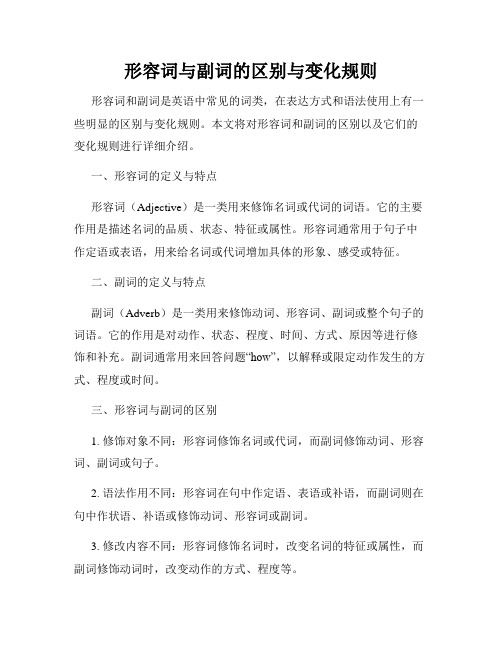
形容词与副词的区别与变化规则形容词和副词是英语中常见的词类,在表达方式和语法使用上有一些明显的区别与变化规则。
本文将对形容词和副词的区别以及它们的变化规则进行详细介绍。
一、形容词的定义与特点形容词(Adjective)是一类用来修饰名词或代词的词语。
它的主要作用是描述名词的品质、状态、特征或属性。
形容词通常用于句子中作定语或表语,用来给名词或代词增加具体的形象、感受或特征。
二、副词的定义与特点副词(Adverb)是一类用来修饰动词、形容词、副词或整个句子的词语。
它的作用是对动作、状态、程度、时间、方式、原因等进行修饰和补充。
副词通常用来回答问题“how”,以解释或限定动作发生的方式、程度或时间。
三、形容词与副词的区别1. 修饰对象不同:形容词修饰名词或代词,而副词修饰动词、形容词、副词或句子。
2. 语法作用不同:形容词在句中作定语、表语或补语,而副词则在句中作状语、补语或修饰动词、形容词或副词。
3. 修改内容不同:形容词修饰名词时,改变名词的特征或属性,而副词修饰动词时,改变动作的方式、程度等。
四、形容词的变化规则1. 基本形式:形容词的基本形式一般是原级(原形),如“big”。
2. 比较级(比较形式):形容词在比较级中加“-er”,如“bigger”。
在一些特殊情况下,形容词的比较级会发生规则变化,如“good”变为“better”、“bad”变为“worse”等。
3. 最高级(最高形式):形容词在最高级中加“-est”,如“biggest”。
同样地,一些形容词在最高级中会有规则变化,如“best”、“worst”。
五、副词的变化规则1. 基本形式:大多数副词的基本形式与形容词相同,只是作用不同,如“loud”(形容词)和“loudly”(副词)。
2. 比较级和最高级:大多数副词的比较级和最高级都是在前面加“more”和“most”,如“more slowly”、“most beautifully”。
形容词和副词教案
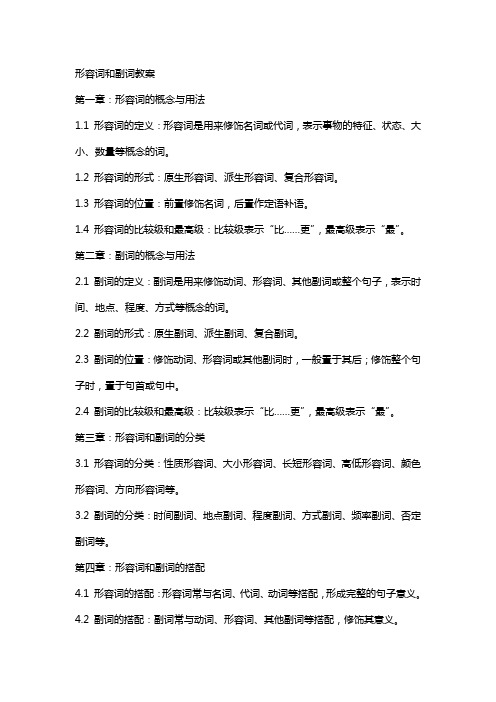
形容词和副词教案第一章:形容词的概念与用法1.1 形容词的定义:形容词是用来修饰名词或代词,表示事物的特征、状态、大小、数量等概念的词。
1.2 形容词的形式:原生形容词、派生形容词、复合形容词。
1.3 形容词的位置:前置修饰名词,后置作定语补语。
1.4 形容词的比较级和最高级:比较级表示“比……更”,最高级表示“最”。
第二章:副词的概念与用法2.1 副词的定义:副词是用来修饰动词、形容词、其他副词或整个句子,表示时间、地点、程度、方式等概念的词。
2.2 副词的形式:原生副词、派生副词、复合副词。
2.3 副词的位置:修饰动词、形容词或其他副词时,一般置于其后;修饰整个句子时,置于句首或句中。
2.4 副词的比较级和最高级:比较级表示“比……更”,最高级表示“最”。
第三章:形容词和副词的分类3.1 形容词的分类:性质形容词、大小形容词、长短形容词、高低形容词、颜色形容词、方向形容词等。
3.2 副词的分类:时间副词、地点副词、程度副词、方式副词、频率副词、否定副词等。
第四章:形容词和副词的搭配4.1 形容词的搭配:形容词常与名词、代词、动词等搭配,形成完整的句子意义。
4.2 副词的搭配:副词常与动词、形容词、其他副词等搭配,修饰其意义。
第五章:形容词和副词的练习5.1 练习一:找出句子中的形容词和副词,并说明它们的作用。
5.2 练习二:用所给的形容词和副词造句,注意其位置和搭配。
5.3 练习三:区分形容词和副词的比较级和最高级,并用它们完成句子。
第六章:形容词和副词的辨别与转换6.1 辨别形容词和副词:通过词尾变化和词性功能来区分形容词和副词。
6.2 形容词转换为副词:通常在形容词后面加上-ly变为副词,但需注意不是所有形容词都可以这样转换。
6.3 副词转换为形容词:在一些情况下,副词可以前面加上-ness变为形容词,表达一种状态或特征。
第七章:形容词和副词在句子中的运用7.1 形容词在句子中的功能:形容词可以作定语、表语、补语等,丰富句子的描述。
形容词与副词讲解
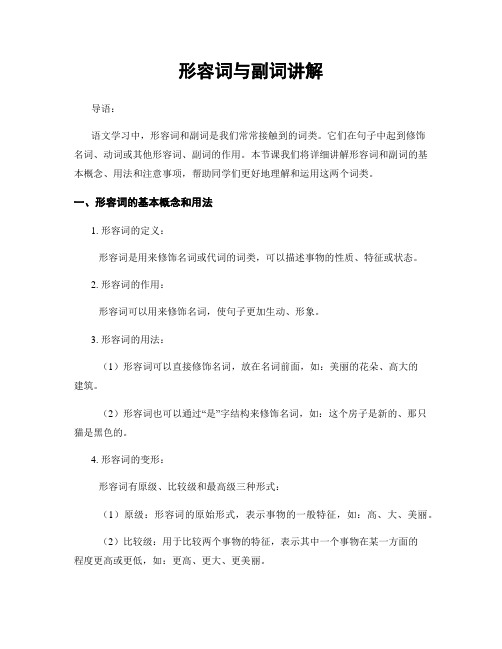
形容词与副词讲解导语:语文学习中,形容词和副词是我们常常接触到的词类。
它们在句子中起到修饰名词、动词或其他形容词、副词的作用。
本节课我们将详细讲解形容词和副词的基本概念、用法和注意事项,帮助同学们更好地理解和运用这两个词类。
一、形容词的基本概念和用法1. 形容词的定义:形容词是用来修饰名词或代词的词类,可以描述事物的性质、特征或状态。
2. 形容词的作用:形容词可以用来修饰名词,使句子更加生动、形象。
3. 形容词的用法:(1)形容词可以直接修饰名词,放在名词前面,如:美丽的花朵、高大的建筑。
(2)形容词也可以通过“是”字结构来修饰名词,如:这个房子是新的、那只猫是黑色的。
4. 形容词的变形:形容词有原级、比较级和最高级三种形式:(1)原级:形容词的原始形式,表示事物的一般特征,如:高、大、美丽。
(2)比较级:用于比较两个事物的特征,表示其中一个事物在某一方面的程度更高或更低,如:更高、更大、更美丽。
(3)最高级:用于比较三个或三个以上事物的特征,表示其中一个事物在某一方面的程度最高或最低,如:最高、最大、最美丽。
二、副词的基本概念和用法1. 副词的定义:副词是用来修饰动词、形容词、其他副词或整个句子的词类,可以表示时间、地点、方式、程度等概念。
2. 副词的作用:副词可以使句子更加丰富、准确,增加句子的表达力。
3. 副词的用法:(1)副词可以修饰动词,表示动作的方式、程度等,如:慢慢地走、非常努力地学习。
(2)副词可以修饰形容词,表示形容词的程度,如:非常漂亮、很高兴。
(3)副词可以修饰其他副词,表示副词的程度,如:非常快速地跑、很认真地听。
(4)副词可以修饰整个句子,表示整个句子的态度、语气等,如:幸运地,我们赢得了比赛。
4. 副词的变形:副词有原级、比较级和最高级三种形式,变形规则和形容词相似。
三、形容词和副词的注意事项1. 形容词和副词的区别:形容词主要修饰名词,副词主要修饰动词、形容词或其他副词。
语文知识点形容词和副词的区别

语文知识点形容词和副词的区别形容词和副词是语文中的重要知识点,它们都是修饰词,但在使用和含义方面有一些区别。
本文将详细介绍形容词和副词的区别。
一、形容词的基本概念和用法形容词是一种词类,主要用来描绘、修饰名词或代词,以增强句子的描述能力。
形容词可以表示事物的性质、特征、状态等。
1. 形容词修饰名词形容词通常位于名词前,用来修饰名词,表示名词的性质或特征。
比如:- 美丽的花朵(修饰名词“花朵”,表达花朵的性质)- 高大的建筑物(修饰名词“建筑物”,表达建筑物的特征)2. 形容词作表语形容词可以作为表语,与系动词搭配使用,表示主语的性质或状态。
比如:- 这个城市很繁华(形容词“繁华”作表语,描述城市的状态)- 孩子们都开心(形容词“开心”作表语,描绘孩子们的状态)3. 形容词的比较级和最高级形容词可以有比较级和最高级形式,用来比较两个或多个事物的程度。
比如:- 我的书比你的书更有趣(用比较级形式比较两本书的趣味性)- 这是我见过的最美的景色(用最高级形式表达对景色美的评价)二、副词的基本概念和用法副词也是一种修饰词,一般用来修饰动词、形容词、副词、句子等,以增强句子的描写能力。
1. 副词修饰动词副词修饰动词时,常表示动作的方式、频率、程度等。
比如:- 他快速地跑过来(副词“快速地”修饰动词“跑”,表示动作的方式)- 我经常去看电影(副词“经常”修饰动词“去看”,表示动作的频率)2. 副词修饰形容词或副词副词可以修饰形容词或副词,增强其程度或放大其意义。
比如:- 这个问题非常困难(副词“非常”修饰形容词“困难”,表示程度)- 她跑得很快(副词“很”修饰副词“快”,表示程度)3. 副词在句子中的其他用法副词还可以用来修饰整个句子或表示某种程度上的否定等。
比如:- 恐怕晚餐要推迟了(副词“恐怕”修饰整个句子,表示推测)- 他并不高兴(副词“并不”表示程度上的否定)三、形容词和副词的区别形容词和副词在使用和含义上有以下几点区别:1. 修饰的对象不同形容词修饰名词,描述名词的性质或特征;副词修饰动词、形容词、副词等,描述动作的方式、程度等。
形容词和副词教案

形容词和副词教案第一章:形容词的概念与用法1.1 形容词的定义:形容词是用来修饰名词或代名词的词,表示事物的特征、状态、大小、数量等。
1.2 形容词的位置:形容词通常放在名词或代名词之前。
1.3 形容词的比较级和最高级:通过在形容词后面加-er和-est来形成比较级和最高级。
第二章:副词的概念与用法2.1 副词的定义:副词是用来修饰动词、形容词、其他副词或整个句子的词,表示时间、地点、程度、方式等。
2.2 副词的位置:副词可以放在动词、形容词或其他副词之前,也可以放在句首或句尾。
2.3 副词的比较级和最高级:通过在副词后面加-er和-est来形成比较级和最高级。
第三章:形容词和副词的搭配3.1 形容词和副词的搭配关系:形容词用来修饰名词,副词用来修饰动词、形容词、其他副词或整个句子。
3.2 形容词和副词的常用搭配:例如:“美丽的风景”、“快乐地唱歌”。
3.3 形容词和副词的搭配练习:让学生通过填空、改写等练习,掌握形容词和副词的正确搭配用法。
第四章:形容词和副词的比较级和最高级4.1 形容词和副词的比较级和最高级的形成规则:通过在形容词和副词后面加-er和-est来形成比较级和最高级。
4.2 形容词和副词的比较级和最高级的用法:表示事物的比较和最高程度。
4.3 形容词和副词的比较级和最高级练习:让学生通过填空、改写等练习,掌握形容词和副词的比较级和最高级用法。
第五章:形容词和副词的语法练习5.1 形容词和副词的填空练习:让学生在句子中填入适当的形容词和副词。
5.3 形容词和副词的综合练习:让学生通过完成句子、短文等,综合运用形容词和副词。
第六章:形容词和副词在句子中的运用6.1 形容词和副词的作用:形容词和副词在句子中起到修饰名词、动词和其他副词的作用,使句子更加具体形象。
6.2 形容词和副词的并列使用:在句子中可以使用多个形容词和副词来修饰同一个名词或动词。
6.3 形容词和副词的倒装:在某些情况下,形容词和副词可以放在它们所修饰的名词或动词之后。
形容词和副词(共19张PPT)

04
形容词和副词的特殊用法
形容词的特殊用法
形容词作名词
形容词的比较级和最高级
某些形容词可以作为名词使用,如“ 幸福”、“成功”等,表示一种状态 或结果。
形容词有比较级和最高级的用法,用 于描述程度或数量的差异,如“更快 ”、“最高”等。
形容词修饰名词
形容词可以放在名词前面,用来描述 名词的特征或属性,如“美丽的花朵 ”、“高大的建筑”等。
详细描述
副词用于描述动词、形容词或其他副词的行为方式、程度、时间、频率等,对于准确表达动作或状态的细节至关 重要。通过副词选择题,可以练习副词在不同语境中的用法,如描述动作发生的时间、方式、频率等,判断副词 的正确用法和意义。
综合练习
总结词
提高综合运用形容词和副词的能力
详细描述
综合练习是将形容词和副词结合在一起使用的练习方式,通过设置语境和情境,让学生根据上下文选 择合适的形容词和副词,以增强学生对形容词和副词的理解和应用能力。综合练习可以包括填空、改 错、翻译等形式,让学生在实际运用中提高对形容词和副词的掌握程度。
副词的比较级和最高级
副词的比较级
用于描述动作、状态或方式在两个或更多的人或事物之间的 相对差异。通常在副词后加“-er”或“more + 副词原形” 构成比较级。例如,“faster”和“more beautifully”。
副词的最高级
用于描述动作、状态或方式在三个或更多的人或事物中的最 高或最低程度。通常在副词后加“-est”或“most + 副词原 形”构成最高级。例如,“fastest”和“most beautifully”。
THANK YOU
ห้องสมุดไป่ตู้感谢各位观看
表示动作的程度,如“very”、 “too”、“quite”、“almost”等 。
形容词和副词的知识点归纳
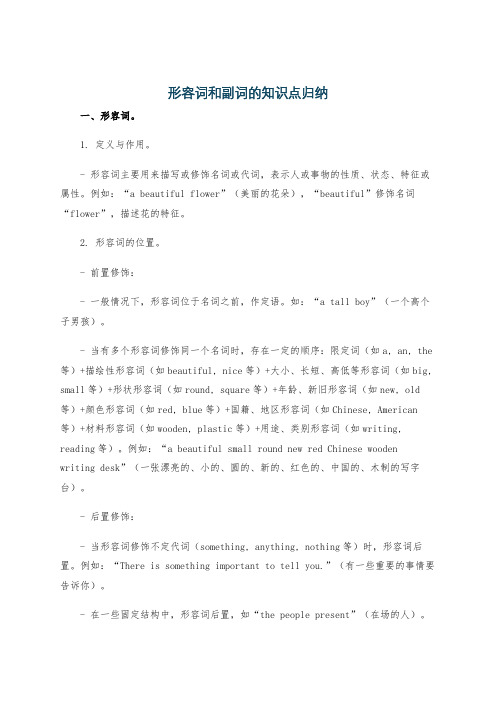
形容词和副词的知识点归纳一、形容词。
1. 定义与作用。
- 形容词主要用来描写或修饰名词或代词,表示人或事物的性质、状态、特征或属性。
例如:“a beautiful flower”(美丽的花朵),“beautiful”修饰名词“flower”,描述花的特征。
2. 形容词的位置。
- 前置修饰:- 一般情况下,形容词位于名词之前,作定语。
如:“a tall boy”(一个高个子男孩)。
- 当有多个形容词修饰同一个名词时,存在一定的顺序:限定词(如a, an, the 等)+描绘性形容词(如beautiful, nice等)+大小、长短、高低等形容词(如big, small等)+形状形容词(如round, square等)+年龄、新旧形容词(如new, old 等)+颜色形容词(如red, blue等)+国籍、地区形容词(如Chinese, American 等)+材料形容词(如wooden, plastic等)+用途、类别形容词(如writing, reading等)。
例如:“a beautiful small round new red Chinese woodenwriting desk”(一张漂亮的、小的、圆的、新的、红色的、中国的、木制的写字台)。
- 后置修饰:- 当形容词修饰不定代词(something, anything, nothing等)时,形容词后置。
例如:“There is something important to tell you.”(有一些重要的事情要告诉你)。
- 在一些固定结构中,形容词后置,如“the people present”(在场的人)。
3. 形容词的比较级和最高级。
- 规则变化:- 一般在词尾加 -er(比较级)和 -est(最高级)。
如:tall - taller - tallest。
- 以不发音的e结尾的单词,加 -r和 -st。
如:nice - nicer - nicest。
高中英语语法-形容词和副词

quick、fast与soon: quick往往指反应速度快, fast往往指运动速度快, soon则表示时间上很快即将发生: After a quick breakfast, he hurried to school. A train is much faster than a bus. His father will be back to China very soon.
Tony is going camping with ______ boys. A. little two other B. two little other C. two other little D. little other two
答案:C. 由\“限定词--数词--描绘
One day they crossed the ____bridge behind the palace. A. old Chinese stone B. Chinese old stone C. old stone Chinese D. Chinese stone old 答案A. 年龄+国家+材料。
(3) tall与high: Tall 指身高的高度,用于人和动物, 反义词为 short He is very short/tall. High 指物体的高度,另可形容价格,质量等, 反义词为low The kite is flying very high. Tall和high都可用来指tree, building, tower等, 但mountain只能用high形容。
1.Chinese, glass, a, beautiful, table a beautiful Chinese glass table 2.wonderful, my, garden, new, large my wonderful large new garden 3. a, round, table, small a small round table 4. a, old, dirty, brown shirt a dirty old brown shirt
形容词和副词的知识点归纳英语

形容词和副词的知识点归纳英语一、形容词。
1. 定义与作用。
- 形容词主要用来修饰名词,表示人或事物的性质、状态和特征等。
例如:a beautiful flower(美丽的花朵),“beautiful”描述了“flower”的特征。
2. 形容词的位置。
- 前置修饰:一般放在所修饰的名词之前。
如:a tall boy(一个高个男孩)。
- 后置修饰:- 当修饰不定代词时,形容词后置。
例如:something interesting(有趣的事情)。
- 在一些固定结构中,如“the +形容词”表示一类人时,形容词后置。
例如:the old(老人),the young(年轻人)。
3. 形容词的比较级和最高级。
- 比较级的构成。
- 一般在形容词词尾加 -er。
例如:tall - taller。
- 以e结尾的形容词,直接加 -r。
如:nice - nicer。
- 重读闭音节,双写尾字母再加 -er。
例如:big - bigger。
- 以“辅音字母 + y”结尾的形容词,把y变为i再加 -er。
如:heavy - heavier。
- 不规则变化:good/well - better,bad/badly - worse,many/much - more 等。
- 最高级的构成。
- 一般在形容词词尾加 -est。
例如:tall - tallest。
- 以e结尾的形容词,直接加 -st。
如:nice - nicest。
- 重读闭音节,双写尾字母再加 -est。
例如:big - biggest。
- 以“辅音字母 + y”结尾的形容词,把y变为i再加 -est。
如:heavy - heaviest。
- 不规则变化:good/well - best,bad/badly - worst,many/much - most 等。
- 比较级和最高级的用法。
- 比较级用于两者之间的比较,常用结构有:A+be+形容词比较级+than + B。
形容词与副词的区别及用法
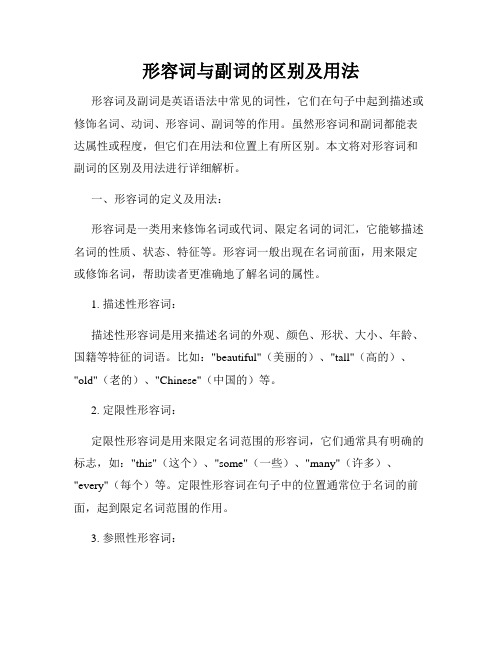
形容词与副词的区别及用法形容词及副词是英语语法中常见的词性,它们在句子中起到描述或修饰名词、动词、形容词、副词等的作用。
虽然形容词和副词都能表达属性或程度,但它们在用法和位置上有所区别。
本文将对形容词和副词的区别及用法进行详细解析。
一、形容词的定义及用法:形容词是一类用来修饰名词或代词、限定名词的词汇,它能够描述名词的性质、状态、特征等。
形容词一般出现在名词前面,用来限定或修饰名词,帮助读者更准确地了解名词的属性。
1. 描述性形容词:描述性形容词是用来描述名词的外观、颜色、形状、大小、年龄、国籍等特征的词语。
比如:"beautiful"(美丽的)、"tall"(高的)、"old"(老的)、"Chinese"(中国的)等。
2. 定限性形容词:定限性形容词是用来限定名词范围的形容词,它们通常具有明确的标志,如:"this"(这个)、"some"(一些)、"many"(许多)、"every"(每个)等。
定限性形容词在句子中的位置通常位于名词的前面,起到限定名词范围的作用。
3. 参照性形容词:参照性形容词是指与名词间具有某种关联或对比关系的形容词,它们通常是根据上下文的需要来确定其具体含义的形容词。
比如:"former"(前任的)、"same"(相同的)、"different"(不同的)等。
二、副词的定义及用法:副词是一类用来修饰动词、形容词、其他副词或整个句子的词汇,它可以表示时间、地点、程度、方式、原因、频率等概念。
副词可以帮助读者更加准确地理解句子中动作发生的时间、地点、方式以及程度等信息。
1. 时间副词:时间副词用来描述动作发生的时间,它可以回答以下问题:"when"(什么时候)或"how long"(多久)等。
形容词和副词的区别及运用
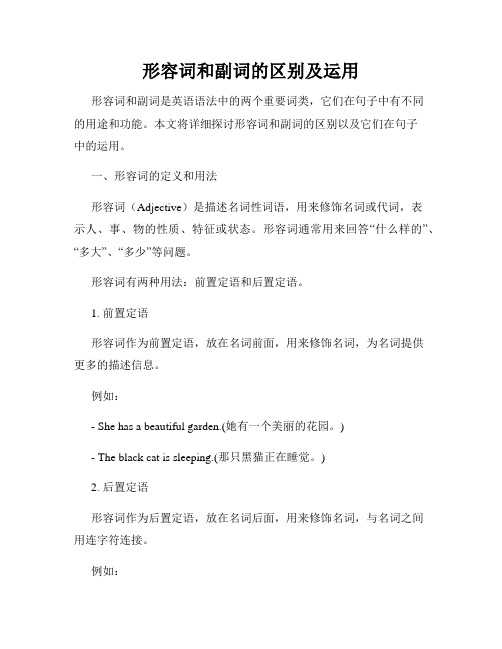
形容词和副词的区别及运用形容词和副词是英语语法中的两个重要词类,它们在句子中有不同的用途和功能。
本文将详细探讨形容词和副词的区别以及它们在句子中的运用。
一、形容词的定义和用法形容词(Adjective)是描述名词性词语,用来修饰名词或代词,表示人、事、物的性质、特征或状态。
形容词通常用来回答“什么样的”、“多大”、“多少”等问题。
形容词有两种用法:前置定语和后置定语。
1. 前置定语形容词作为前置定语,放在名词前面,用来修饰名词,为名词提供更多的描述信息。
例如:- She has a beautiful garden.(她有一个美丽的花园。
)- The black cat is sleeping.(那只黑猫正在睡觉。
)2. 后置定语形容词作为后置定语,放在名词后面,用来修饰名词,与名词之间用连字符连接。
例如:- The girl is kind-hearted.(这个女孩是善良的。
)- I bought a coffee table made of oak.(我买了一张由橡木制成的咖啡桌。
)二、副词的定义和用法副词(Adverb)是描述动词、形容词、副词和整个句子的词语,用来修饰动词、形容词、副词,表示行为的方式、程度、时间、地点等。
副词有多种用法:修饰动词、形容词和副词;修饰整个句子;表示时间、地点、方式、程度等。
1. 修饰动词副词可以用来修饰动词,表示行为的方式、频率、时间等。
例如:- He speaks English fluently.(他流利地讲英语。
)- They often go to the park on weekends.(他们经常在周末去公园。
)- She arrived late yesterday.(她昨天到达得很晚。
)2. 修饰形容词和副词副词可以用来修饰形容词或副词,表示程度或方式。
例如:- It is very hot today.(今天非常热。
)- He runs incredibly fast.(他跑得非常快。
小学英语语法——形容词与副词知识点讲解+练习

形容词和副词一、形容词、副词概述1、形容词定义:形容词(adjective),简称adj,用来修饰名词或代词,表示人或事物的性质、状态和特征。
2、副词定义:副词(adverb),简称adv,用来修饰动词、形容词或副词,表示时间、频率、范围、语气、程度等。
二、形容词、副词考点纵览三、综合练习( ) 1. How beautifully she sings! I have never heard _____ voice.A. a betterB. a bestC. the betterD. the best ( ) 2. She looks very _____ but I can’t remember her name.A. similarB. familiarC. friendlyD. strange ( ) 3. Children all looked _____ at the broken model plane and felt quite _____.A. sad; sadB. sadly; sadlyC. sad; sadlyD. sadly; sad( ) 4. The child dreamed that he had once lived in a _______ house in the forest.A. wooden pretty littleB. little pretty woodenC. pretty little woodenD. wooden little pretty( ) 5. ---Which team is _______ to win the game?---I don’t know, but I’ve found _______ for ours to win.A. probable; it unlikelyB. likely; it possibleC. possible; it possibleD. likely; it possibly( ) 6. With the development of the Internet, _______ communication is done by regular mail.A. lessB. moreC. littleD. few( ) 7. ---If you don’t like the red coat, take the blue one.---OK, but do you have ______ size in blue? This one’s a bit tight for me.A. a bigB. a biggerC. the bigD. the bigger( ) 8. If there were no examinations, we should have ______ at school.A. the happiest timeB. a more happier timeC. much happiest timeD. a much happier time( ) 9. This dress is prettier, but it costs ______ that one.A. twice more thanB. twice as much asC. as much twice asD. twice so much as( ) 10.________students are required to take part in the boat race.A. Ten strong young ChineseB. Ten Chinese strong youngC. Chinese ten young strongD. Young strong ten Chinese( ) 11. Allen had to call a taxi because the box was ____to carry all the way home.A. much too heavyB. too much heavyC. heavy too muchD. too heavy much( ) 12. Our neighbor has ________ours.A. as a big house asB. as big a house asC. the same big house asD. a house the same big as( ) 13. We were in ________when we left that we forgot the airline tickets.A. a rush so anxiousB. a such anxious rushC. so an anxious rushD. such an anxious rush( ) 14. ---I was riding along the street and all of a sudden, a car cut in and knocked me down.---You can never be ________careful in the street.A. muchB. veryC. soD. too( ) 15. ---You don’t look very ________.Are you ill?---No,I’m just a bit tired.A. goodB. wellC. strongD. healthy( ) 16. Four of Robert’s children were at the party,including ________, Luke.A. the eldestB. an oldest oneC. the oldD. an old one( ) 17. Many students signed up for the ________race in the sports meeting to be held next week.A. 800-metre-longB. 800-metres-longC. 800 metre lengthD. 800 metres length( ) 18. It’s always difficult being in a foreign country,________if you don’t speak the language.A. extremelyB. naturallyC. basicallyD. especially( ) 19. In recent years,travel companies have succeeded in selling us the idea that the further we go,__________.A. our holiday will be betterB. our holiday will be the betterC. the better our holiday will beD. the better will our holiday be( ) 20. When he heard a cry for help, he ran out as ________ as he could.A. hardlyB. quicklyC. finallyD. slowly( ) 21. “Our team is _____ to win the match.” “Really? But I don’t think so.”A. easyB. difficultC. possibleD. sure( ) 22. A ______ road goes ______ from one place to another.A. straight; straightB. straightly; straightlyC. straight; straightlyD. straightly; straight( ) 23. “This book is ______ more useful for us students.” “Yes, but it is _______ too difficult.”A. quite; quiteB. much; ratherC. rather; quite D quite; much( ) 24. There was a ______ change in the weather, and the rain came pouring down.A. quickB. slowC. fastD. sudden( ) 25. You can speak ______ in front of him, but you can’t eat ______ in his restaurant.A. freely; freelyB. free; freelyC. freely; freeD. free; free( ) 26. Tom will not be at the picnic, ______ to the family’s disappointment.A. muchB. moreC. too muchD. much more( ) 27. --- I have seen so little of Mike ______. Is he away on business?--- Oh, no. He just leaves for his office early and comes back very ______.A. later; latelyB. later; laterC. lately; lateD. late; lately( ) 28. From his ______ voice on the phone I know everything is well under way.A. satisfactoryB. satisfyingC. satisfiedD. satisfaction( ) 29. In ______ Chinese culture, marriage decisions were often made by parents for their children.A. traditionalB. historicC. peacefulD. civil( ) 30. The houses in the village are ______ built of wood and hay.A. mostB. almostC. nearlyD. mostly( ) 31. --- What do people wear when they go to the theatre?--- Well, it isn’t very ______. People can wear anything they like.A. normalB. certainC. modernD. simple( ) 32. Mary’s biology is ______ than ______ in the class.A. a lot of better; anyone else’sB. far better; anyone’s else’sC. much better; anyone elseD. a lot better; anyone else’s( ) 33. We decided not to climb the mountains because it was raining ____.A. badlyB. hardlyC. stronglyD. heavily( ) 34. Paris is one of _____ cities in the world.A. more beautifullyB. more beautifulC. the most beautifullyD. the most beautiful ( ) 35. Are you going to leave______?A. the open windowsB. the windows openingC. the windows openD. the windows opened( ) 36. Bob never does his homework _____ Mary, so he makes lots of mistakes.A. so careful asB. as carefully asC. carefully asD. as careful as.( ) 37. My sister is good at sports. She can jump ____ than me.A. highestB. very highC. too highD. much higher ( ) 38. When spring comes, the trees get ____.A. green and greenB. green and greenerC. greener and greenD. greener and greener( ) 39.He works very ___________.He _____________has a rest on Sundays.A. hard; hardlyB. hardly; hardC. hard; hardD. hardly; hardly( ) 40.He learns Russian_____________.A. goodB. niceC. wellD. fine( ) 41.The boy didn’t run______________ to catch the bus.A. fast enoughB. enough fastC. quick enoughD. enough quickly ( ) 42.Eating _____________ is bad for our health.A. much tooB. too muchC. too moreD. too many( ) 43.Have you ever seen ______________ big panda before?A. a suchB. such aC. so aD. as( ) 44.He looks very _____________ today.A. worriedB. worryC. worryingD. to worry( ) 45.Listen to me. I have _____________ to tell you.A. important somethingB. important anythingC. something importantD. anything important( ) 46. ---How ___ can you finish the drawing?--- In ten minutes.A. longB. often.C. soonD. rapid( ) 47. This book is _____ worth seeing again.A. veryB. quiteC. wellD. much( ) 48. My _____ brother is three years ____ than I .A. old; olderB. elder; olderC. older; elderD. old; elder( ) 49. We felt ___ after we watched the ___ football match.A. exciting; excitedB. excited; excitingC. excited; excitedD. exciting; exciting( ) 50. The old man lived ____ in the house, but he didn’t feel___.A. lonely; lonelyB. alone; lonelyC. alone; aloneD. lonely; alone小学英语语法——形容词与副词知识点讲解+练习参考答案1. A2.B3.D4.C5.B6.A7.B8.D9.B 10.A 11. A 12.B 13.D 14.D 15.B 16.A 17.A 18.D 19.C 20.B 21. D 22.A 23.B 24.D 25.C 26.A 27.C 28.C 29.A 30.D 31. B 32.D 33.D 34.D 35.C 36.B 37.D 38.D 39.A 40.C 41. A 42.B 43.B 44.A 45.C 46.C 47.C 48.B 49.B 50.B11。
形容词和副词教案

形容词和副词教案第一章:形容词的概念与用法1.1 形容词的定义:形容词是用来修饰名词或代名词的词,表示事物的性质、状态、特征等。
1.2 形容词的形式:原形、比较级、最高级。
1.3 形容词的位置:通常放在名词或代名词之前。
1.4 形容词的搭配:使用合适的介词与形容词搭配,如“美丽的花朵”、“快速的奔跑”。
第二章:副词的概念与用法2.1 副词的定义:副词是用来修饰动词、形容词、其他副词或整个句子的词,表示时间、地点、程度、方式等。
2.2 副词的形式:原形、比较级、最高级。
2.3 副词的位置:通常放在动词、形容词或其他副词之后,句子之前。
2.4 副词的搭配:使用合适的介词与副词搭配,如“慢慢地走”、“仔细地观察”。
第三章:形容词和副词的比较级和最高级3.1 比较级的构成:一般在形容词和副词后面加上-er或-er,如“taller”、“faster”。
3.2 最高级的构成:在形容词和副词后面加上-est或-est,如“tallest”、“fastest”。
3.3 比较级和最高级的用法:表示两个或多个事物之间的比较关系,如“She is the tallest in our class.”第四章:形容词和副词的短语4.1 形容词短语:由形容词和其他词组成的短语,如“big yellow car”、“quickly run”。
4.2 副词短语:由副词和其他词组成的短语,如“now and then”、“slowly”。
4.3 形容词和副词短语的用法:丰富词汇,表达更准确的意思。
第五章:形容词和副词在句子中的运用5.1 形容词在句子中的作用:修饰名词或代名词,如“The red car is fast.”5.2 副词在句子中的作用:修饰动词、形容词或其他副词,如“She sings beautifully.”5.3 形容词和副词的搭配:合理运用介词,如“I like eating apples.”本教案旨在帮助学生掌握形容词和副词的基本概念、形式、用法和搭配,能够正确运用形容词和副词丰富句子的表达。
形容词与副词的用法总结修饰名词与动词的不同方式

形容词与副词的用法总结修饰名词与动词的不同方式在英语语法中,形容词和副词是常用的词性,用于修饰名词和动词。
它们的使用方式有一些不同,下面将对形容词和副词在修饰名词和动词方面的用法进行总结。
一、形容词(Adjective)形容词用于修饰名词,可以表示名词的特征、状态、性质等。
常常出现在名词的前面或后面,用以描述或限定名词,从而让读者更准确地理解名词所代表的事物。
1. 形容词修饰名词时,通常放在名词的前面,如:a beautiful flower (一朵美丽的花),a tall building(一座高耸的大楼)。
2. 有些形容词可以放在名词的后面,如:the room clean(干净的房间),a man honest(一个诚实的人)。
这种情况通常是指那些在修饰特定的名词时,形容词只能放在名词的后面。
二、副词(Adverb)副词用于修饰动词、形容词、其他副词等,可以表示动作的方式、程度、频率等。
副词的作用是进一步描述或限定动词的动作,使其更具体、更生动。
1. 副词修饰动词时,通常放在动词的后面,如:She runs quickly(她跑得快),He speaks fluently(他说得流利)。
2. 副词修饰形容词时,通常放在形容词的前面,如:a highly intelligent student(一个非常聪明的学生),an extremely beautiful sunset(一场极其美丽的日落)。
3. 副词修饰其他副词时,通常放在被修饰的副词的前面,如:She walks very slowly(她走得很慢),He speaks quite softly(他说得相当轻声)。
需要注意的是,有些形容词和副词形式相同,只有在句子中的位置不同。
这就需要根据具体上下文来判断其作用。
总结起来,形容词主要用于修饰名词,而副词主要用于修饰动词、形容词、其他副词。
在使用上,形容词通常放在名词前面,而副词通常放在被修饰词的后面,这样可以更准确地表达出名词和动词的特征、状态、性质、方式、程度等。
中考英语语法:形容词和副词(2-副词)

形容词和副词(2-副词)●副词的构词:1)大部分形容词+ ly = 副词e.g.deep --> deeply ; loud --> loudly2)以y结尾的形容词,改y为i,+ ly = 副词e.g.happy --> happily ; easy --> easily3)以le结尾的形容词,去e,+ y = 副词e.g. possible --> possibly ; reliable --> reliably4)不规则变化e.g. good --> well ; bad --> worse5)有些副词和形容词同形初中考纲中有七个形容词和副词形式相同: ahead; early; fast; hard; high; late; straight The road ahead was blocked.I’ll run ahead.The early part of her life was spent in Paris.I get up early everyday.He is a fast learner.The water was rising fast.Diamonds are hard.You must try hard.I looked down from the high window.We should aim high and do our best to achieve our goal.She is late for work everyday.I got up late.He was too tired to walk straight.You look better with straight hair.●副词的用法副词在句中用作状语。
e.g.It's raining hard.Don’t drive too fast.This is a fairly useful tool.Luckily, he still got first prize.●副词的位置1)方式状态的副词(Adverbs of Manner)这一类副词是修饰动词专用的,典型拼法是形容词加上-ly。
形容词和副词的英语语法讲解(2)
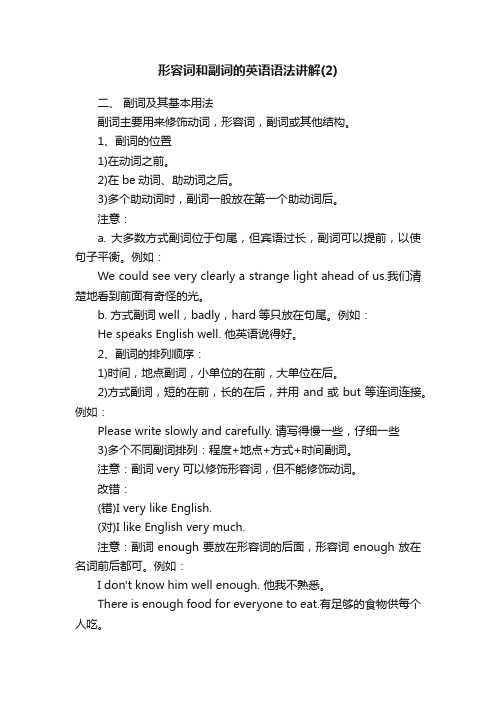
形容词和副词的英语语法讲解(2)二、副词及其基本用法副词主要用来修饰动词,形容词,副词或其他结构。
1、副词的位置1)在动词之前。
2)在be动词、助动词之后。
3)多个助动词时,副词一般放在第一个助动词后。
注意:a. 大多数方式副词位于句尾,但宾语过长,副词可以提前,以使句子平衡。
例如:We could see very clearly a strange light ahead of us.我们清楚地看到前面有奇怪的光。
b. 方式副词well,badly,hard等只放在句尾。
例如:He speaks English well. 他英语说得好。
2、副词的排列顺序:1)时间,地点副词,小单位的在前,大单位在后。
2)方式副词,短的在前,长的在后,并用and或but等连词连接。
例如:Please write slowly and carefully. 请写得慢一些,仔细一些3)多个不同副词排列:程度+地点+方式+时间副词。
注意:副词very 可以修饰形容词,但不能修饰动词。
改错:(错)I very like English.(对)I like English very much.注意:副词enough要放在形容词的后面,形容词enough放在名词前后都可。
例如:I don't know him well enough. 他我不熟悉。
There is enough food for everyone to eat.有足够的食物供每个人吃。
There is food enough for everyone to eat.3、兼有两种形式的副词1) close与closelyclose意思是"近";closely 意思是"仔细地"。
例如:He is sitting close to me. 他就坐在我边上。
Watch him closely. 盯着他。
2) late 与latelylate意思是"晚";lately 意思是"最近"。
- 1、下载文档前请自行甄别文档内容的完整性,平台不提供额外的编辑、内容补充、找答案等附加服务。
- 2、"仅部分预览"的文档,不可在线预览部分如存在完整性等问题,可反馈申请退款(可完整预览的文档不适用该条件!)。
- 3、如文档侵犯您的权益,请联系客服反馈,我们会尽快为您处理(人工客服工作时间:9:00-18:30)。
第二节形容词与副词第一部分近年高考题荟萃2009年高考题1. (09安徽24)—Do you think it's a good idea to make friends with your students?— , I do. I think it's a great idea.A. ReallyB. ObviouslyC. ActuallyD. Generally答案 C2. (09福建30)It seems that living green is easy and affordable. A small step masks a big difference.A. exactlyB. fortunatelyC. surprisinglyD. hardly答案 C解析考查副词。
exactly:准确地;fortunately:幸运地;surprisingly:惊讶地,出乎意料地;hardly:几乎不。
题干意思是:似乎保护环境是出乎意料的简单可行,小小的行动能带来很大的不同。
选C。
3. (09湖北27)As there is less and less coal and oil, scientists are exploring new ways of making use of ______ energy, such as sunlight, wind and water for power and fuel.A. primaryB. alternativeC. instantD. unique答案 B解析考查形容词。
既然石油和煤都越来越少,人们只好使用一些其它可替代这些燃料的东西,alternative 有“可选择的,可替代的”之意,符合句意。
primary“首要的,初期的”,instant“立即的,迅速的”,unique“独特的”。
4. (09湖北28)The questionnaire takes ______ ten to fifteen minutes to complete and can be used along with the assessment interview.A. mainlyB. punctuallyC. approximatelyD. precisely答案C解析考查副词。
这里意思是“问卷大约需要10至15分钟完成”,应选择approximately“大约地”。
mainly“主要地”,punctually“准时地”,precisely“精确地”。
5.(09湖南24)I can be a teacher. I’m not a very patient person.A. seldomB. everC. neverD. always答案 C解析句意为:我绝不会成为一名教师。
因为我不是一个很有耐心的人。
seldom表示“很少”;ever表示“永远”用在肯定句中;never表示“绝不,从来没有” always 表示“总是”。
6. (09江西32)Frank put the mediocre in the top drawer to make sure it would not be_______ to the kids.A. accessibleB. relativeC. acceptableD. sensitive答案 A解析考查形容词的辨析。
Be accessible to 为……能够接近;be relative to 和……有关系; be acceptable to 为……所接受;be sensitive to 对……敏感, 易接受。
7. (09海南23)How much she looked without her glasses!A. wellB. goodC. bestD. better答案 D解析考查系动词后跟形容词作表语。
句意为:没有眼镜她看的多么好?与戴眼镜形成对比。
8. (09四川19)My uncle’s house in the downtown area is much smaller than ours , but it is twice _______ expensive .A. asB. soC. tooD. very答案 A解析考查倍数的表示方法。
该题采用了“倍数+as+adj./adv+as ”这一结构,所以答案为A。
9. (09天津12)It was a nice house, but _______ too small for a family of live.A. rarelyB. fairlyC. ratherD. pretty答案C10. (09天津13)I’m not surprised that he became a writer. Even as a child he had a _____ imagination.A. clearB. cautiousC. funnyD. vivid答案 D11.(09浙江5)The incomes of skilled workers went up. ______, unskilled workers saw their earnings fall.A. MoreoverB. ThereforeC. MeanwhileD. Otherwise答案C13.(09浙江19)In the good care of the nurses, the boy is ______ recovering from his heart operation.A. quietlyB. actuallyC. practicallyD. gradually答案 D14. (09全国Ⅱ9)The children loved their day trip, and they enjoyed the horse ride .A. mostB. moreC. lessD. little答案 A解析考查形容词(immediate)、副词等(most、much too与too much的区别)15. (09全国Ⅱ11)I’m sure that your letter will get attention. They know you’re waiting for the reply.A. continuedB. immediateC. carefulD. general答案 B解析考查形容词(immediate)、副词等(most、much too与too much的区别)16. (09全国Ⅱ18)It’s high time you had your hair cut ; it’s getting .A. too much longB. much too longC. long too muchD. too long much答案 B解析考查形容词(immediate)、副词等(most、much too与too much的区别)17. (09江苏27)Compared with his sister, Jerry is even more A. skeptical B. addicted C. available D. sensitive to, and more easily troubled by , emotional and relationship problems.答案 D2008年高考题1.(08全国Ⅰ28)You ’re driving too fast.Can you drive ? A.more slowly a bit B.slowly a bit moreC.a bit more slowlyD.slowly more abit 答案 C解析 考查a bit 用来修饰比较级的用法。
2.(08全国Ⅰ32)The weather was cold that I didn ’t like to leave my room. A.reallyB.suchC.tooD.so 答案 D解析 考查so...that 这一结构。
3.(08全国Ⅱ19)The house still needed a lot of work ,but the kitchen was finished. A.insteadB.altogetherC.at onceD.at least答案 D解析 句意为:尽管这所房子仍然需要大量工作(才能建完),但至少厨房已经竣工了。
D 项意为“至少”,根据句意知此项符合;A 项意为“相反”;B 项意为“总共”;C 项意为“立刻,马上”。
4.( 08北京26)After the long journey , the three of them went back home , _____ . A. hungry and tiredlyB. hungry and tiredC. hungrily and tiredlyD. hungrily and tired答案 B解析句意为:长途旅行后他们三人回家了,又累又饿。
由句式结构看,空格处应作为状语使用,四个选项中均使用了并列连词and,故and前后的词性应该一致,且英语中形容词或形容词短语可作为状语使用,表示主语的状态,故应选择B项。
5.(08天津2)My brother is really ___ _. He often works in his office far into the night.A. open-mindedB. hard-workingC. self-confidentD. warm-hearted 答案 B解析 open-minded 思想开明的,坦率的;hard-working 勤劳的,努力工作的;self-confident 自信的;warm-hearted 热心肠的。
句意为:我弟弟真是能干,他经常在办公室里工作到深夜。
6.(08天津15)At the railway station,the mother waved goodbye to her daughter until the train was _______.A. out of sightB. out of reachC. out of orderD. out of place答案 A解析 out of sight看不见;out of reach够不到;out of order杂乱,出故障;out of place不在原来的地方,不恰当。
句意为:在火车站,这位母亲挥手向她的女儿告别,直到火车看不见为止。
